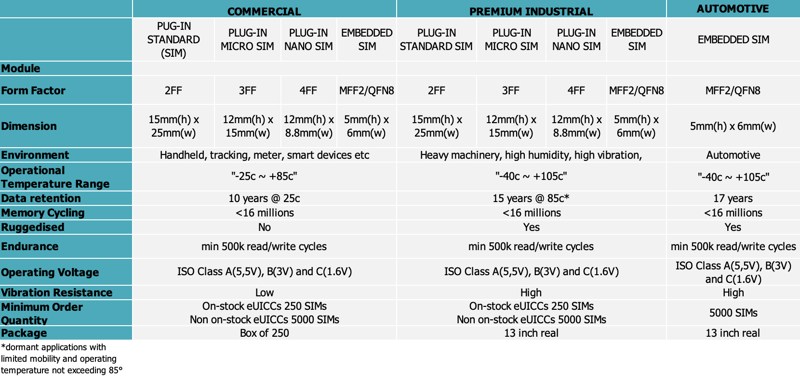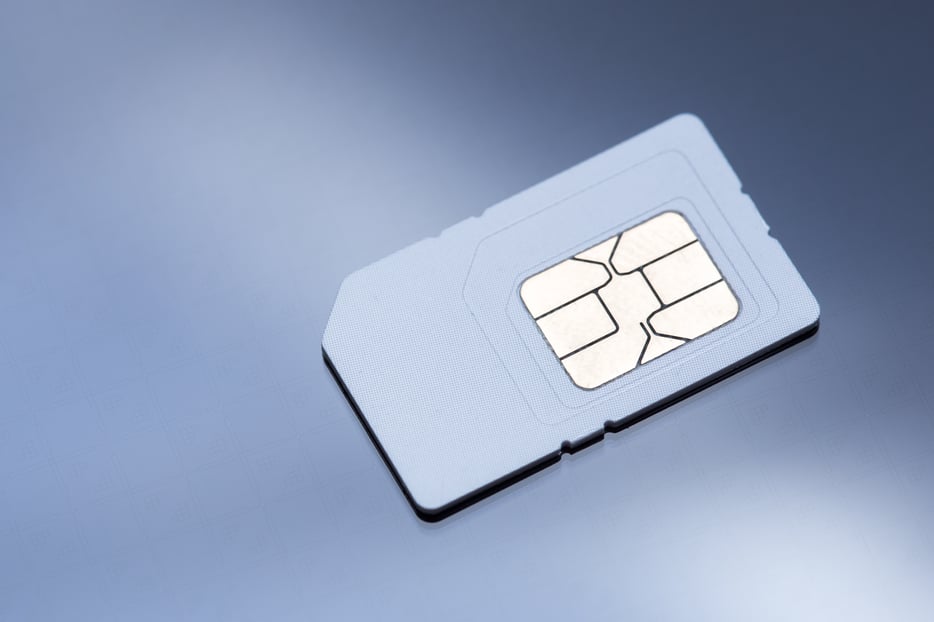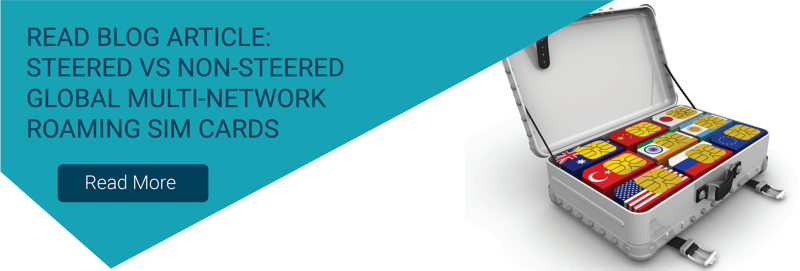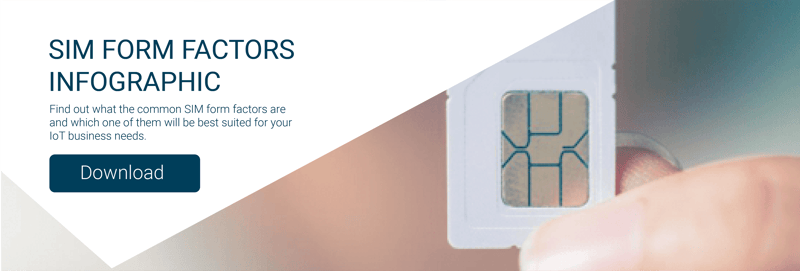What is an IoT SIM card?
An IoT/M2M SIM card is a variation of the traditional SIM cards used in personal mobile devices like smartphones with additional features designed for IoT devices. SIM cards designed for the Internet of Things include greater durability, security, and flexibility.
Machine to Machine SIM cards work by establishing a connection to your host network and transferring data between your device and the rest of your IoT platform. While you could technically use consumer SIM cards for this purpose, in practice this is not recommended, as consumer SIMs do not meet the needs of most IoT solutions.
IoT devices have unique needs from other smart devices like phones and tablets. For example, they need to maintain a secure connection at nearly all times, survive in harsher conditions, and meet the specific needs of your IoT project's goals.
Why are IoT SIM cards different?
IoT SIMs and traditional SIMs perform the same primary function – keeping internet-enabled devices connected to the Internet. However, that's where the similarities between the two end.
IoT SIMs not only need to keep devices connected, but they need to be remotely manageable as well. This is because they are typically activated in bulk, whereas regular SIMs are activated one at a time by an individual consumer.
IoT SIMs are also created to support data plan aggregation, where every SIM added to an IoT project increases the data cap. This kind of data plan makes IoT projects more affordable and cost-effective.
How durable are IoT SIMs?
IoT devices often survive in harsh conditions, exposed to strong winds, high or low temperatures, rain, humidity, and excessive movement. Therefore, they are built to be substantially more rugged than their traditional counterparts.
Outdoor IoT applications often use industrial or automotive-grade SIM cards, which are more resistant to corrosion and the weather. They're also made to survive extreme vibrations, as well as temperatures ranging from -40°C to 105°C (-40°F to 221°F).
Using IoT SIMs means you can deploy your IoT devices into harsh environments without worrying about losing your SIM to the elements.
What is the lifespan of an IoT SIM compared to a standard SIM?
The lifespan of your IoT devices' SIMs is an important factor to keep in mind, as replacing a SIM can be difficult - if not impossible - depending on how your devices are deployed.
Traditional SIMs only have a lifespan of about three years, which is far too short to be practical for Machine-to-Machine (M2M) applications. On the other hand, IoT or M2M SIM cards come in a few different form factors, each with a different lifespan. They are highly durable, and most can last up to ten years before needing to be replaced.
Embedded SIMs, in particular, are exceptionally durable due to being surface mounted to your devices and having a vacuum seal. These can last more than ten years, even in unforgiving environments, making them a sustainable choice for immobile connected devices.
Steered vs non-steered multi-network open roaming IoT SIM card
A significant portion of IoT devices are remote or mobile and require roaming on multiple networks. However, the way your SIM connects outside of your primary network when roaming can differ. Unlike consumer SIMs, IoT SIM cards can offer steered or non-steered multi-network roaming to match your needs.
Steered IoT SIM cards will prefer your chosen provider's network, even if there is a stronger network available. They will stay connected to the mobile network operator of your choice until they are completely out of range, which may result in IoT devices losing connection or operating on a very poor signal if there is no fallback selected.
Non-steered ones do not prioritise the available networks and connect to the strongest network available, even if that is not the original provider's network. This could be done through set agreements between operators that allow noon-steer SIMs to jump on the strongest signal. Non-steered connections are crucial for many IoT devices, most notably medical or tracking, where the device must have an uninterrupted connection.
IoT SIM models and their functionality
There are three IoT SIM models:
Standard IoT SIMs
These are SIM cards designed for IoT, but they're still built on the backbone of traditional SIM cards. So, you'll get the features you need to keep your IoT devices connected and manageable, without the extra overhead of durability. These work well for IoT devices in temperate, less harsh environments.
Industrial IoT SIMs
Industrial SIMs are much more durable and designed to survive extreme conditions. They're resistant to high and low temperatures, vibrations, corrosion and other unfavourable conditions.
Automotive IoT SIMs
Similar to industrial IoT SIMs, Automotive SIMs are built to be much more durable than standard SIMs, specifically when it comes to connected motor vehicles. These are resistant to more extreme temperatures, the weather, and the vibrations and motion that go along with moving vehicles.

Choosing the right SIM form factor for your IoT applications
Full-Size (1FF)
This is the largest SIM card form factor, about the size of a credit card. It is no longer used in most modern devices.
Mini-SIM (2FF)
This is the industry standard SIM card size, measuring 25mm x 15mm x 0.76mm. It's typically used in devices like vehicles, vending machines, and payment points.
Micro-SIM (3FF)
The micro-SIM is half the size of the mini and is used in more portable devices like tablets, GPS, smart heatlh, and other mobile IoT devices.
Nano-SIM (4FF)
The nano-SIM is 40% smaller than the micro variation, making it great for small IoT devices. These SIMs are not very well protected, however, so they are not recommended for devices in harsh environments.
Embedded SIM (MFF2)
Embedded SIMs, also known as eSIMs, are the most popular option for IoT devices. These SIMs are soldered onto your IoT devices, directly, so there's no need to install them. They measure only 6mm x 5mm x 1mm and are one of the most durable IoT SIM options.
What is eUICC and how does it work?
UICC stands for Universal Integrated Circuit Card, which is part of the functionality within SIM cards that help identify a device on a particular mobile network. Historically, this has been a static element of SIM cards, meaning that for every SIM card, there is one UICC associated with it.
It is possible that the UICC can migrate to another physical SIM, but if it does, then it is no longer associated with the original SIM, and no other UICCs can be associated with the new SIM. But with a few exceptions (like multi-IMSI SIMs), SIM cards have worked in this way for the last couple of decades.
This is not the case with eUICCs (Embedded Universal Integrated Circuit Card), an 'embedded' UICC, as dubbed by the industry, which has nothing to do with physical embedding.
eUICCs is the software that eliminates the profile lock on SIMs and enables SKUs (single SIM) to hold more than a single mobile network operator profile. Services associated with eUICC are often dubbed eSIM, embedded SIM, digital SIM or iSIM based on their remote provisioning capabilities, form factor or simply the provider's naming choice.
Like any technology, using an eUICC or eSIM comes with a set of challenges, like the extensive testing an OTA network profile requires during implementation. To learn more about how eSIM works and the implications and advantages, look at our selection of blogs on the topic.
How to secure IoT SIM Cards?
A concern that IoT project managers quickly encounter with IoT technology is security. Each IoT device has access to the central network, can upload and download data, and therefore poses a security risk. Not to mention that the nature of certain IoT projects, such as smart cities, can place IoT devices within reach of the public.
For these reasons, keeping your IoT devices as secure as possible is a top priority, and that includes keeping your IoT SIMs safe. One of the most common ways to keep IoT SIM cards secure is through a private APN.
IoT SIMs use a private APN, as opposed to a standard, shared MNO one. This allows only devices with the right credentials to connect to your network, unlike traditional cellular, where you and anyone else with the same carrier as you are using the same network. In addition, SIM cards for M2M are often configured with fixed public or private IPs, and each connectivity provider adds a layer of network protection against network attacks.
What is a private APN network and why do IoT SIMs need it?
APN is short for "Access Point Name," and it acts as a middleman between a particular network and the devices trying to connect with it. Any device that wants to connect to an APN network needs a SIM specially programmed to access that network.
There are several benefits to using private APNs, primarily around security. Devices with a private APN can only be accessed through their certified network. There is no way for someone to connect to your IoT devices without accessing your whole network. Having a limited number of verified devices on the network will also prevent it from becoming congested due to sharing bandwidth with consumer-level devices.
What is a Fixed IP SIM Card?
An IoT/M2M SIM card that has a fixed IP address is one whose IP address will never change. This allows you to access your devices with a fixed IP address more reliably and securely, no matter where your devices are located - a necessity in the world of IoT.
What is a static IP address and why would you need one?
An IP address is more or less your device's identity when accessing the internet, similar to a building's address. IP addresses come in two varieties, dynamic and static.
Dynamic IP addresses are usually used in consumer devices and change every time a device connects to the internet. This can make it hard to keep track of devices using dynamic IP addresses, which is helpful for consumer privacy, but not so helpful when you're trying to keep track of a system of IoT devices.
Static IP addresses - or fixed IP addresses - are addresses that will never change, no matter how many times a device connects to the internet. So, if your IoT devices all have fixed IP addresses, you'll be able to access them at their specific IP address whenever you need them. This gives you guaranteed visibility and control of your IoT devices, as well as complete end-to-end security and encryption.
Check out the Velos IoT fixed private IP models.
In addition, the IP addresses can be divided into public fixed IPs or private fixed IPs. When the device requires to connect through a number of internet hosts, then gets assigned a public IP address that would allow it to connect on a global scale. On the other hand, private fixed IP addresses are defined within a specified network, allowing for a more secure local outreach for an organisation.
How to provide SIM IoT security without affecting device performance?
Another struggle that IoT devices face is implementing security measures without adding too much to your devices' workload. Even a small increase in processor capability - when multiplied across the hundreds/thousands of devices in your IoT network - can turn into a surprisingly big investment.
IoT devices often jump from private to public networks and can access the Internet. When exposed to the public, it is important to keep your applications extra safe.
Fortunately, you can combat vulnerability with VPNs. A VPN - Virtual Private Network - encrypts your device's connection to the Internet, so none of the other devices on the Internet are able to access your own or view its data. And, best of all, this can be done without adding any extra processor requirements to your IoT devices
What is an IPsec VPN and how does it make IoT SIMs secure?
IPsec VPNs are a subset of VPNs that use IPsec protocol to keep your VPN secure. IPsec VPNs are the most secure available, making them ideal for transferring sensitive data over your network.
IPsec protocol - short for Internet Protocol Security - is a security measure that authenticates and encrypts data being sent through it. It makes sure that every device connecting through it is a trusted device, that all data being transmitted is safe, and that all data being transferred is encrypted and secure from potential threats.
IoT projects that use IPsec VPNs give you the highest level of security possible through a VPN. Not only that, but all of these security features are conducted by your network, so there's no extra strain on your IoT devices.
Why you should choose Velos IoT SIMs?
Velos IoT's machine-to-machine SIMs are designed for the rigorous uses of IoT. We support both eSIM and multi-IMSI solutions and allow free hopping between all the networks available in a particular country, with dynamic IP addresses, fixed IP or IP SEC VPN.
Velos IoT SIMs Features:
SIMs made for devices
Make sure your devices are connected anywhere in the world by utilising our +600 networks. Set up your preferred networks or use the strongest signal available for your device to ensure a reliable connection.
Global resilient connectivity
With 600+ roaming agreements in over 210 countries and territories, Velos IoT has the best-in-class global network coverage. So your devices will spend less time searching for networks and stay connected at all times. We specialise in providing access to regions with roaming restrictions like Canada and Brazil.
All SIM form factors + eSIM
Velos IoT's IoT SIMs are available in all SIM form factors: Standard SIM (2FF), Micro SIM (3FF), Nano SIM (4FF), and MFF2 embedded chips. In addition, we offer eSIM for remote mobile network profile provisioning.
Connectivity Management Platform
Manage your device connectivity via our Nomad Connectivity Management Platform. Gain insights into your data usage, device locations, network access and behavioural patterns. Set alarms, perform device-level operations and optimise expenditure with our complete SIM estate overview.
IoT Security
Manage your own IoT security from one single provider regardless of the numbers and locations of your devices already distributed worldwide. Set device connectivity parameters and get notified in case of deviations. Control device network access rights and geo-fence them if needed.










